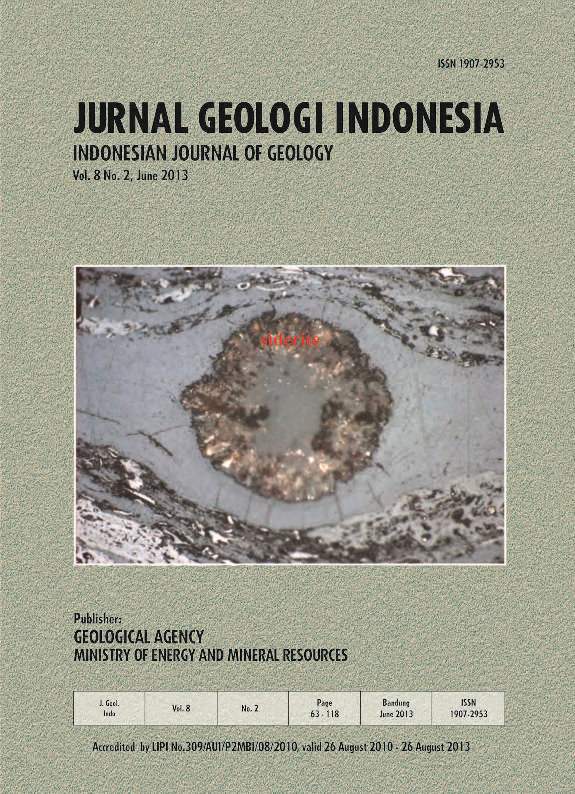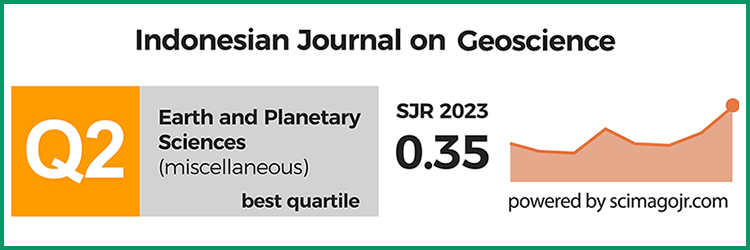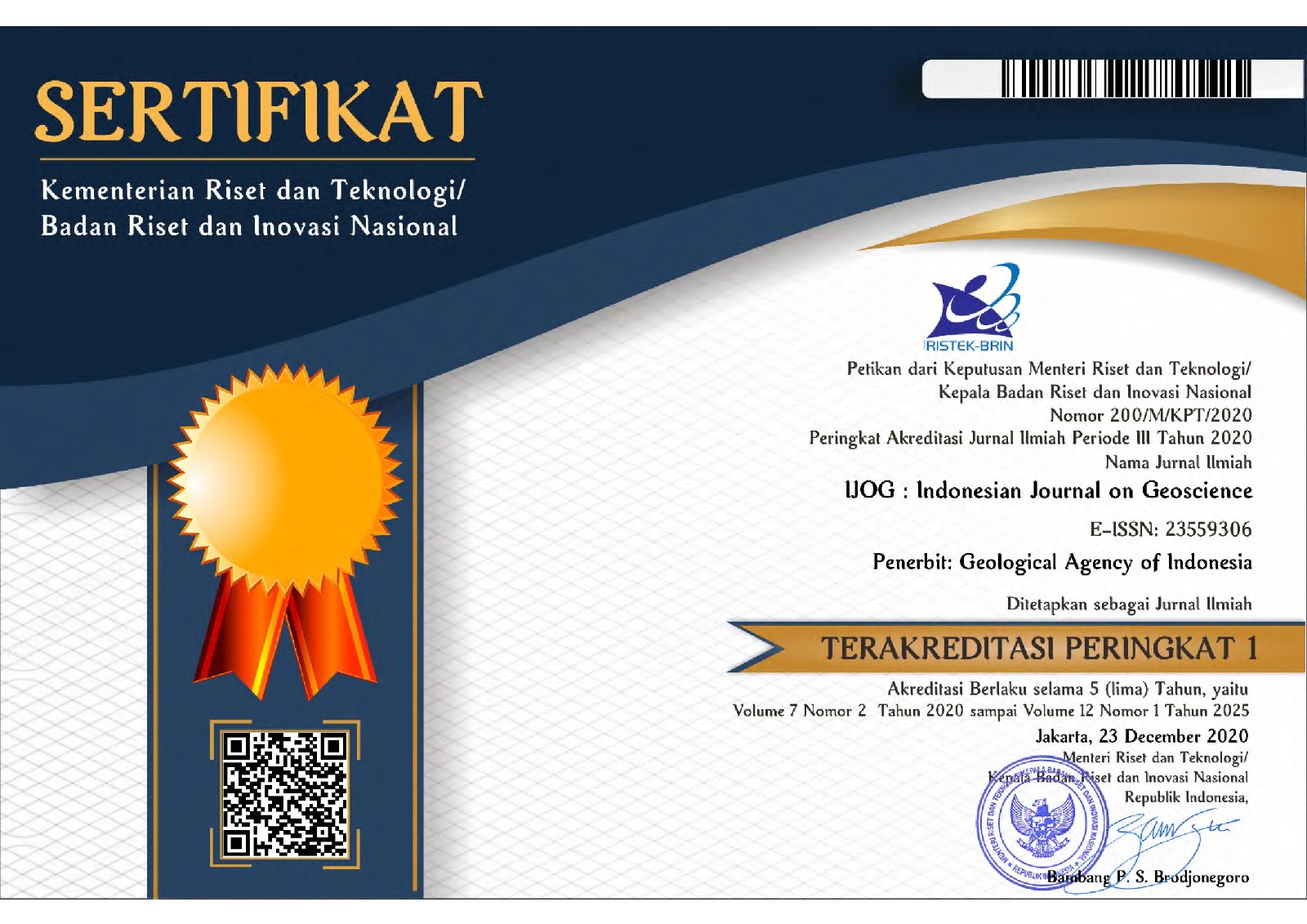Morphostructural Development of Gunungsewu Karst, Jawa Island
DOI:
https://doi.org/10.17014/ijog.8.2.75-88Keywords:
Gunungsewu karst, simple to composite landforms, paleo-breaker lines, active tectonicsAbstract
Gunungsewu Karst (also known as Sewu karst in the literature) is synonymous with morphology of a carbonate terrain dominated by hills crowned by accordant-level tops that developed in a humid tropical environment by comparatively more rapid dissolution and denudation. In addition, the hills are sinoid to cone-shaped. Surface drainage is negligible compared to subsurface water flow. Abandoned channel segments and spatial arrangements of karst hills have been found to correspond with fracture patterns that are genetically associated with the regional compression direction of Jawa Island. Images derived from space platforms show many landform patterns that were neither known from ground-based nor from aerial photograph study. Landforms arranged in ring, multi-ring, spiral, polygonal, and long linear to serpentine patterns are common beside the expected depressions of dolines, poljes, and uvalas. The orientations of the long linear ridges appear to change systematically from those near the coast to those located inland. These linear ridges are interpreted as depositional fronts, most likely representing breaker zones. The youngest depositional ridge fronts, located nearest to the present shoreline, are parallel to the geological strike of Jawa Island. Toward the island’s interior, linear depositional fronts deviate in orientation by as much as 40o. This is now interpreted to have resulted from counterclockwise rotation of the Gunungsewu microplate since the late Middle Miocene. Similar CCW rotations are indicated by the paleomagnetic orientations of igneous rocks located farther east in the southern range of the island. Active tectonics is expressed in stage-wise net uplift of Gunungsewu whereas regional tilting appears negligible. Stacked and often paired river terraces (thus suggesting land uplift) have been used to relatively date paleoarcheological finds. Very recent uplift on the coast show up in lazy-V limestone notch profiles, and occasionally by stacked notches. At the Klayar coast, slight northward tilt of a few degrees are expressed as counter-regional inclination of a subrecent abrasion platform.
References
Escher, B.G. 1951. Grondslagen der Algemene Geologie. Wereldbibliotheek, Amsterdam: Figures 294, 295, 298, 299, and 300.
Flathe, H. and Pfeiffer, D., 1965. Grundzuege der Geomorpholgie, Geologie und Hydrogeologie im Karstgebiet Gunung Sewu (Java, Indonesien). Geologisches Jahrbuch, B. 83, p.533-562.
Grund, A., 1914. Der geographisches Zyklus im Karst. Gesellschaft fuer Erdkunde, B.52, p.621-624.
Hartono, G. and Bronto, S., 2007. Asal usul pembentukan Gunung Batur di daerah Wediombo, Gunungkidul, Yogyakarta. Jurnal Geologi Indonesia, 7(3), p.143-158. doi:10.17014/ijog.vol2no3.20073
Haryono, E. and Day, M., 2004. Landform differentiation within the Gunung Sewu kegelkarst, Java, Indonesia. Journal of Cave and Karst Studies, 66 (2), p.62-69.
Lehmann, H., 1936. Morphologische Studien auf Java. Geographische Abandlungen, Series 3(9), p.1-141.
Ngkoimani, L.O., 2005. Magnetization of andesites rocks of Java and their implication to the paleomagnetization and tectonic evolution; abstract. Kumpulan Abstrak Disertasi S3, Institut Teknologi Bandung, Internet.
Ngkoimani, L.O., Bijaksana, S., and Abdullah, C.I., 2006. Magnetic and geo-chronological constraints on the Cretaceous-Miocene tectonic evolution of Java. Proceedings, International Geosciences Conference and Exhibition, Jakarta, August 14-16, 06-SOT-11, 4pp.
Rahardjo, W., Sukandarrumidi, and Rosidi, H.M.D., 1995. Peta Geologi Lembar Yogyakarta, Jawa, skala 1 : 100 000. Pusat Penelitian dan Pengembangan Geologi, Bandung.
Samodra, H., 2007. Korelasi Antara Morfogenesis dan Perkembangan Lembah Sadeng Dengan Pola Arah Struktur Geologi Akibat Tektonik di Kawasan Kars Gunung Sewu, Kabupaten Gunungkidul, Yogyakarta. Universitas Padjadjaran (Bandung), Tesis S-2, 178pp.
Samodra, H., Gafoer, S., and Tjokrosapoetro, S., 1992. Peta Geologi Lembar Pacitan, Jawa, skala 1 : 100 000. Pusat Penelitian dan Pengembangan Geologi, Bandung.
Sartono, S., 1964. Stratigraphy and sedimentation of the easternmost part of Gunung Sewu (East Java). Publikasi Teknik Seri Geologi Umum 1, Direktorat Geologi, Bandung.
Surono, B., Toha, and Sudarno, I., 1992. Peta Geologi Lembar Surakarta-Giritontro, Jawa, skala 1 : 100 000. Pusat Penelitian dan Pengembangan Geologi, Bandung.
Tjia, H.D., 1962. Topographic lineaments in Nusa Barung, East Java. Institut Teknologi Bandung. Proceedings, 2 (2), p.89-98.
Tjia, H.D., 1969. Slope development in tropical karst. Zeitschrift fuer Geomorphologie, 13 (3), p.260-266.
Tjia, H.D. and Samodra, H., 2011. Active crustal deformation at the coast of Gunung Sewu, Jawa. Proceedings, Asian Trans-Disciplinary Karst Conference, p.17-21.
Tjia, H.D., and Mastura, S.S.A., 2013. Sea-level Changes in Peninsular Malaysia: A Geological Record. Universiti Kebangsaan Malaysia Publisher, Bangi, Malaysia, 150pp.
Verstappen, H. Th., 1960. On the geomorphology of raised coral reefs and its tectonic significance. Zeitschrift fuer Geomorphologie, B. 4 (1), p.1-28.



















